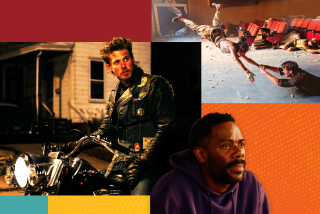‘Four Feathers’ Melts in Heat of the Desert
- Share via
The key fact about “The Four Feathers” is not that the venerable, 100-year-old novel it’s based on has already been filmed six times. It’s that three of those versions were silent, and the most famous adaptation of all was made in 1939, likely before even the parents of current stars Heath Ledger, Wes Bentley and Kate Hudson were born.
There’s a reason for this. This epic tale of military action and romance is not only set in the Victorian world, it’s key plot point is so Victorian it’s difficult to envision today’s audiences connecting to it. Sensing this, as well as for reasons of their own, director Shekhar Kapur and screenwriters Michael Schiffer and Hossein Amini have tried hard to modernize and reconceptualize things, but the barriers finally prove to be too great.
Director Kapur, as witness his earlier “Elizabeth,” does have a natural gift for pageantry, and the best thing about the Robert Richardson-photographed “The Four Feathers” is the vividness of a look and sensibility that practically scream epic. With the Royal Cumbrian regiment prancing around in nifty red jackets with gold trim, this film’s physical re-creation of Victorian Britain is engaging.
It’s in Britain that we meet best friends and fellow Royal Cumbrians Harry Feversham (Ledger), the son of a general, and Jack Dorrance (Bentley), a brooding, dark-prince type of guy. Though no one seems to notice, both are in love with the same girl, the beautiful Ethne (Kate Hudson, pretty as an ivory cameo), who is in fact engaged to marry the dashing Harry.
Then the regiment gets the news that it is shipping out within a week to fight Muslim fanatics in the Sudan led by a charismatic leader called the Mahdi (played, once upon a time, by Laurence Oliver, of all people, in “Khartoum”). Soldiers being soldiers, almost everyone is delighted. Everyone except Harry.
Handsome though he is, Harry had apparently never wanted to be a soldier, and the assignment to the Sudan has crystallized these feelings, causing him to resign his commission. Though the film can’t seem to decide whether Harry is a man of conscience or a shirker, his friends have no such doubts. Three of them, plus Ethne, give him the dreaded white feather, a symbol that they regard him as--gasp!--a coward!
It is the conceit of “The Four Feathers” that getting these flimsy plumes so shames and mortifies Harry that he goes to the Sudan on his own, disguises himself as an Arab and eventually moves heaven and earth (as well as drinks camel’s blood) to help out his pals.
In today’s me-first age, where public denial of guilt by the most culpable is an everyday event and a sizable portion of the population thinks downloading music is next door to a constitutional right, the idea of your life being ruined by an abstract code of moral conduct symbolized by a feather sounds like the faint echo of a bygone time.
Once the British get to the Sudan, the film begins to depart from its Victorian roots and gains distinctly modern touches, some of them likely unintentional. The Mahdi sounds like a precursor of Osama bin Laden, and seeing British soldiers chasing an elusive Islamic foe in an inhospitable desert climate looks like an eerie prefiguration of U.S. troops in Iraq. And in what feels like a pointed jab at 20th century American imperialism, one character bluntly proclaims, “You English walk too proudly on the Earth.”
If the 1939 British-made “The Four Feathers” had no trouble justifying colonialism, the attitude of this film is less straightforward, something that might be expected given that both director Kapur and co-screenwriter Amini come from cultures that were the victims of colonialism, not its perpetrators.
So the new “Four Feathers” is as intent on showing British savagery and stupidity as in depicting traditional heroism. The film even departs from previous versions by giving Harry a Tonto-like sidekick, Abou Fatma (“Amistad’s” Djimon Hounsou), without whose help he could never have survived, all that camel’s blood notwithstanding. Whether this is progress or not is unclear, but it is different.
All these intriguing good intentions, however, have largely gone for naught because of a variety of missteps, starting with an increasing implausible plot as well as the fact that Ledger’s Harry looks about as likely to pass for an Arab as the Mahdi is to pass for Queen Victoria.
Also, “The Four Feathers” gradually loses its interest in the pageantry that is its strength, opting instead for scenes of suffering as Harry and a pal find themselves incarcerated in a squalid prison camp. This section overshadows all else and turns the ending anticlimactic, not to mention making it seem as if the filmmakers are punishing the Brits for the horrors inflicted on their ancestors. Empire may not have been as glorious as the Victorians imagine, but does it have to be this taxing?
MPAA rating: PG-13, for intense battle sequences, disturbing images, violence and some sensuality. Times guidelines: Some of the scenes of war, imprisonment and torture are fairly graphic.
‘The Four Feathers’
Heath Ledger...Harry
Wes Bentley...Jack
Kate Hudson...Ethne
Djimon Hounsou...Abou Fatma
Michael Sheen...Trench
Paramount Pictures and Miramax Films present, a Jafffilms production, released by Paramount Pictures. Director Shekhar Kapur. Producers Stanley R. Jaffe, Robert D. Jaffe, Marty Katz, Paul Feldsher. Executive producers Allon Reich, Julie Goldstein. Screenplay Michael Schiffer and Hossein Amini, based on the novel by A.E.W. Mason. Cinematographer Robert Richardson. Editor Steven Rosenblum. Costumes Ruth Myers. Music James Horner. Production design Allan Cameron. Supervising art director Keith Pain. Set decorator Peter Howitt. Running time: 2 hours, 7 minutes.
In general release.
More to Read
Only good movies
Get the Indie Focus newsletter, Mark Olsen's weekly guide to the world of cinema.
You may occasionally receive promotional content from the Los Angeles Times.











